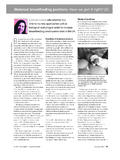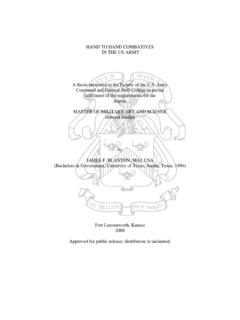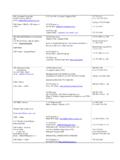Transcription of 1 Review of the Basic Methodology - National …
1 Imbens/Wooldridge, Lecture Notes 10, Summer 07 What s New in Econometrics?NBER,Summer 2007 Lecture 10,Tuesday,July 31st, pmDifference-in-Differences EstimationThese notes provide an overview of standard difference-in-differences methods that havebeen used to study numerous policy questions. We consider some recent advances in Hansen(2007a,b) on issues of inference, focusing on what can be learned with various group/timeperiod dimensions and serial independence in group-level shocks. Both the repeated crosssections and panel data cases are considered. We discuss recent work by Athey and Imbens(2006) on nonparametric approaches to difference-in-differences, and Abadie, Diamond, andHainmueller (2007) on constructing synthetic control of the Basic MethodologySince the work by Ashenfelter and Card (1985), the use of difference-in-differencesmethods has become very widespread. The simplest set up is one where outcomes are observedfor two groups for two time periods.
2 One of the groups is exposed to a treatment in the secondperiod but not in the first period. The second group is not exposed to the treatment duringeither period. In the case where the same units within a group are observed in each time period,the average gain in the second (control) group is substracted from the average gain in the first(treatment) group. This removes biases in second period comparisons between the treatmentand control group that could be the result from permanent differences between those groups, aswell as biases from comparisons over time in the treatment group that could be the result oftrends. We will treat the panel data case in Section repeated cross sections, we can write the model for a generic member of any ofgroups asy 0 1dB 0d2 1d2 dB u ( )whereyis the outcome of interest,d2 is a dummy variable for the second time period. Thedummy variabledBcaptures possible differences between the treatment and control groupsprior to the policy change.
3 The time period dummy,d2, captures aggregate factors that wouldcause changes inyeven in the absense of a policy change. The coefficient of interest, 1,multiplies the interaction term,d2 dB, which is the same as a dummy variable equal to onefor those observations in the treatment group in the second period. Thedifference-in-differences estimate is 1 y B,2 y B,1 y A,2 y A,1 . ( )1 Imbens/Wooldridge, Lecture Notes 10, Summer 07 Inference based on even moderate sample sizes in each of the four groups is straightforward,and is easily made robust to different group/time period variances in the regression some cases a more convincing analysis of a policy change is available by furtherrefining the definition of treatment and control groups. For example, suppose a stateimplements a change in health care policy aimed at the elderly, say people 65 and older, andthe response variable,y, is a health outcome. One possibility is to use data only on people inthe state with the policy change, both before and after the change, with the control group beingpeople under 65 and the treatment group being people 65 and older.
4 The potential problemwith this DD analysis is that other factors unrelated to the state s new policy might affect thehealth of the elderly relative to the younger population, for example, changes in health careemphasis at the federal level. A different DD analysis would be to use another state as thecontrol group and use the elderly from the non-policy state as the control group. Here, theproblem is thatchangesin the health of the elderly might be systematically different acrossstates due to, say, income and wealth differences, rather than the policy more robust analysis than either of the DD analyses described above can be obtained byusing both a different state and a control group within the treatment state. If we again label thetwo time periods as one and two, letBrepresent the state implementing the policy, and letEdenote the group of elderly, then an expanded verson of ( ) isy 0 1dB 2dE 3dB dE 0d2 1d2 dB 2d2 dE 3d2 dB dE u ( )The coefficient of interest is now 3, the coefficient on the triple interaction term,d2 dB OLS estimate 3can be expressed as follows: 3 y B,E,2 y B,E,1 y A,E,2 y A,E,1 y B,N,2 y B,N,1 ( )where theAsubscript means the state not implementing the policy and theNsubscriptrepresents the non-elderly.
5 For obvious reasons, the estimator in ( ) is called thedifference-in-difference-in-differenc es (DDD)estimate. [The population analog of ( ) iseasily established from ( ) by finding the expected values of the six groups appearing in( ).] If we drop either the middle term or the last term, we obtain one of the DD estimatesdescribed in the previous paragraph. The DDD estimate starts with the time change in averagesfor the elderly in the treatment state and then nets out the change in means for elderly in thecontrol state and the change in means for the non-elderly in the treatment state. The hope isthat this controls for two kinds of potentially confounding trends: changes in health status of2 Imbens/Wooldridge, Lecture Notes 10, Summer 07elderly across states (that would have nothing to do with the policy) and changes in healthstatus of all people living in the policy-change state (possibly due to other state policies thataffect everyone s health, or state-specific changes in the economy that affect everyone shealth).
6 When implemented as a regression, a standard error for 3is easily obtained, includinga heteroskedasticity-robust standard error. As in the DD case, it is straightforward to addadditional covariates to ( ) and inference robust to Should We View Uncertainty in DD Settings?The standard approach just described assumes that all uncertainty in inference entersthrough sampling error in estimating the means of each group/time period combination. Thisapproach has a long history in statistics, as it is equivalent to analysis of variance. Recently,different approaches have been suggest that focus on different kinds of uncertainty perhapsin addition to sampling error in estimating means. Recent work by Bertrand, Duflo, andMullainathan (2004), Donald and Lang (2007), Hansen (2007a,b), and Abadie, Diamond, andHainmueller (2007) argues for additional sources of uncertainty. In fact, in most cases theadditional uncertainty is assumed to swamp the sampling error in estimating group/time periodmeans.
7 We already discussed the DL approach in the cluster sample notes, although we did notexplicitly introduce a time dimension. One way to view the uncertainty introduced in the DLframework and a perspective explicitly taken by ADH is that our analysis should betterreflect the uncertainty in the quality of the control we turn to a general setting, it is useful to ask whether introducing more thansampling error into DD analyses is necessary, or desirable. As we discussed in the clustersample notes, the DL approach does not allow inference in the Basic comparison-of-mean casefor two groups. While the DL estimate is the usual difference in means, the error variance ofthe cluster effect cannot be estimated, and thetdistribution is degenerate. It is also the casethat the DL approach cannot be applied to the standard DD or DDD cases covered in Section either have four different means to estimate or six, and the DL regression in these casesproduces a perfect fit with no residual variance.
8 Should we conclude nothing can be learned insuch settings?Consider the example from Meyer, Viscusi, and Durbin (1995) on estimating the effects ofbenefit generosity on length of time a worker spends on workers compensation. MVD have abefore and after period, where the policy change was to raise the cap on covered earnings. Thetreatment group is high earners, and the control group is low earners who should not have3 Imbens/Wooldridge, Lecture Notes 10, Summer 07been affected by the change in the cap. Using the state of Kentucky and a total sample size of5,626, MVD find the DD estimate of the policy change is about (longer time onworkers compensation). Thetstatistic is about , and the estimate changes little whensome controls are added. MVD also use a data set for Michigan. Using the same DD approach,they estimate an almost identical effect: But, with only 1,524 observations, thetstatistic is It seems that, in this example, there is plenty of uncertainty in estimation, andone cannot obtain a tight estimate without a fairly large sample size.
9 It is unclear what we gainby concluding that, because we are just identifying the parameters, we cannot performinference in such cases. In this example, it is hard to argue that the uncertainty associated withchoosing low earners within the same state and time period as the control group somehowswamps the sampling error in the sample Settings for DD Analysis:Multiple Groups and TimePeriodsThe DD and DDD methodologies can be applied to more than two time periods. In the firstcase, a full set of time-period dummies is added to ( ), and a policy dummy replacesd2 dB;the policy dummy is simply defined to be unity for groups and time periods subject to thepolicy. This imposes the restriction that the policy has the same effect in every year, andassumption that is easily relaxed. In a DDD analysis, a full set of dummies is included for eachof the two kinds of groups and all time periods, as well as all pairwise interactions.
10 Then, apolicy dummy (or sometimes a continuous policy variable) measures the effect of the Gruber (1994) for an application to mandated maternity many time periods and groups, a general framework considered by BDM (2004) andHansen (2007b) is useful. The equation at the individual level isyigt t g xgt zigt gt vgt uigt,i 1,..,Mgt, ( )whereiindexes individual,gindexes group, andtindexes time. This model has a full set oftime effects, t, a full set of group effects, g, group/time period covariates,xgt(these are thepolicy variables), individual-specific covariates,zigt, unobserved group/time effects,vgt,andindividual-specific errors,uigt. We are interested in estimating . Equation ( ) is an exampleof amultilevel way to write ( ) that is useful isyigt gt zigt gt uigt,i 1,..,Mgt, ( )4 Imbens/Wooldridge, Lecture Notes 10, Summer 07which shows a model at the individual level where both the intercepts and slopes are allowedto differ across all g,t pairs.
















